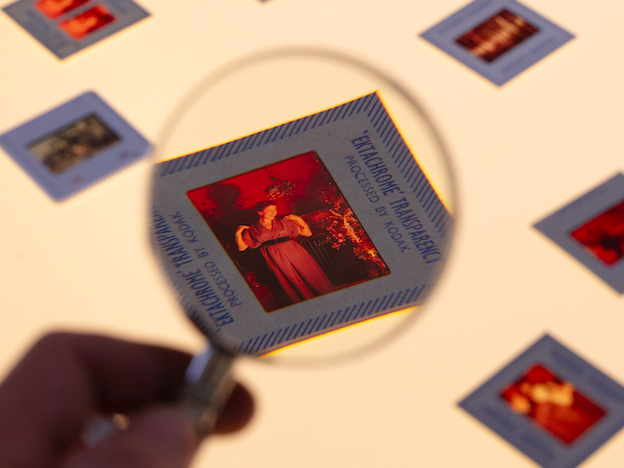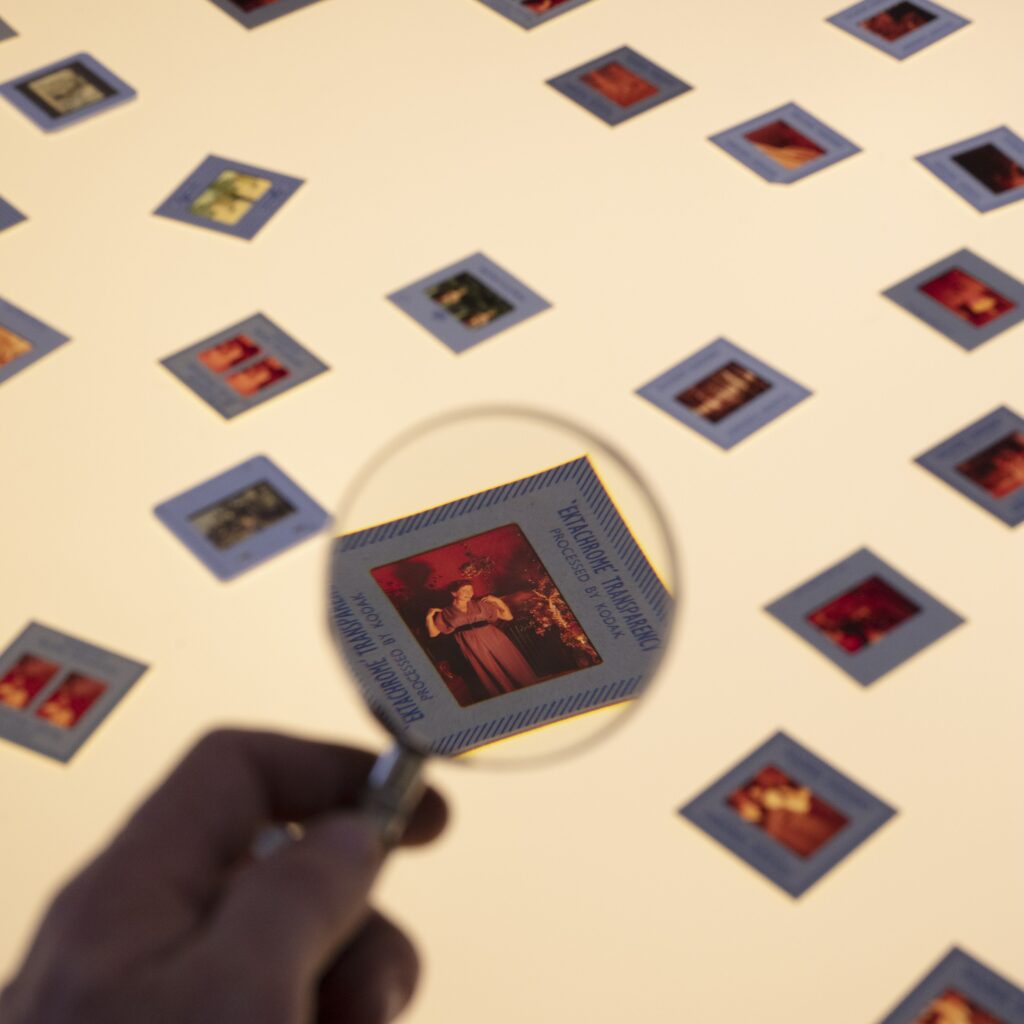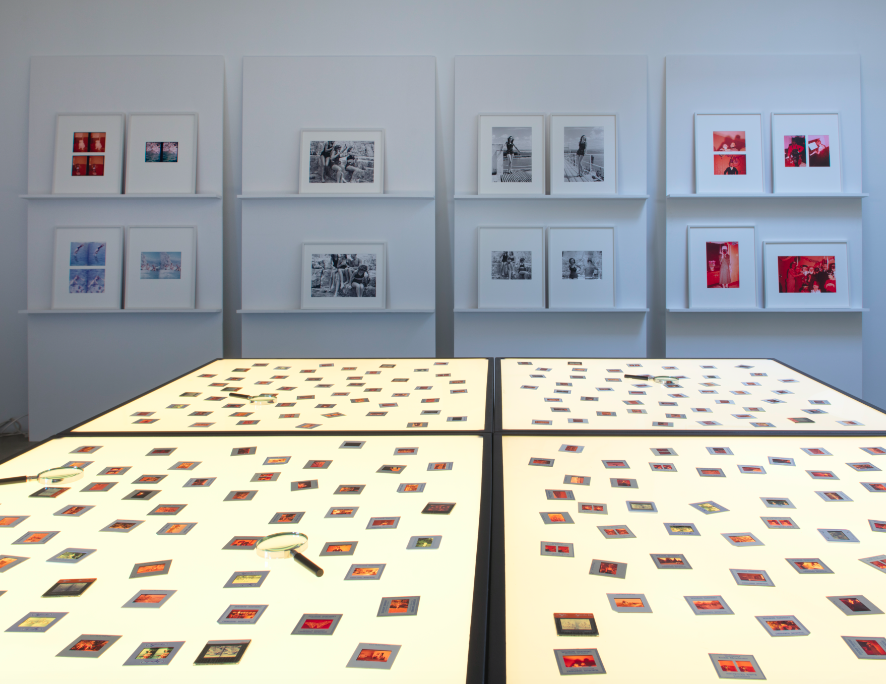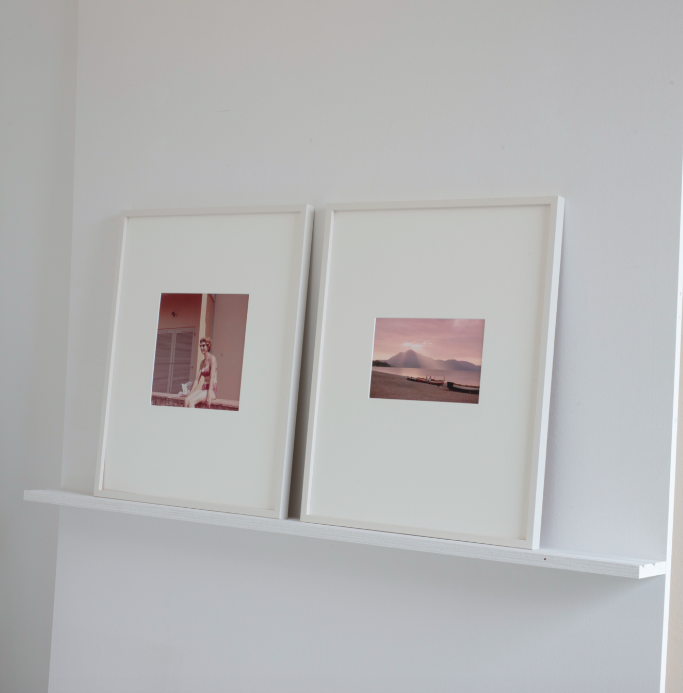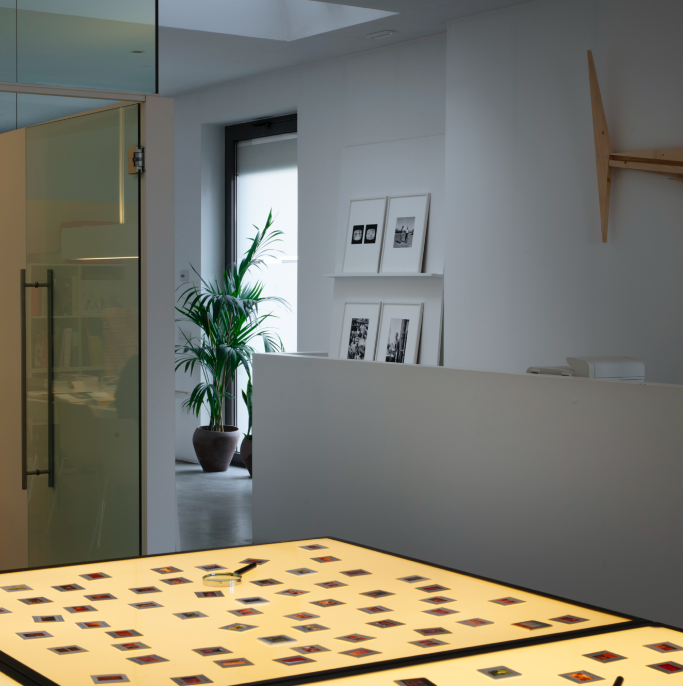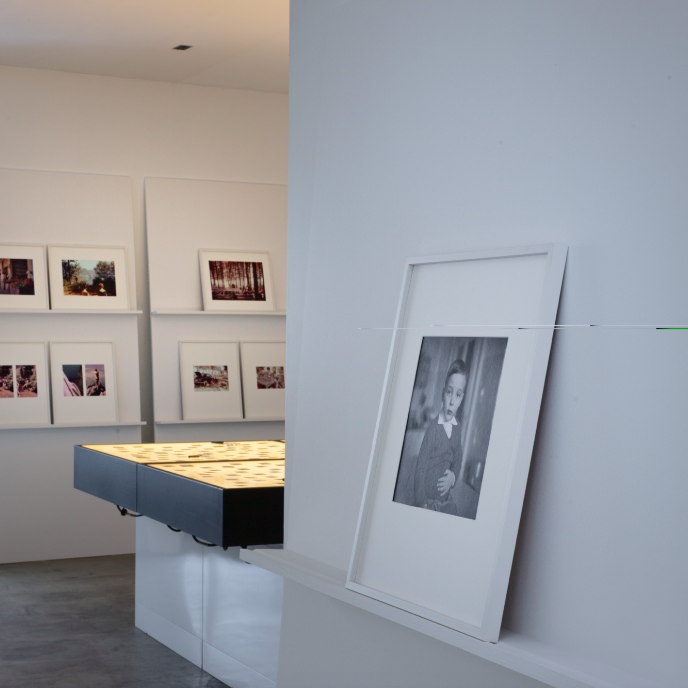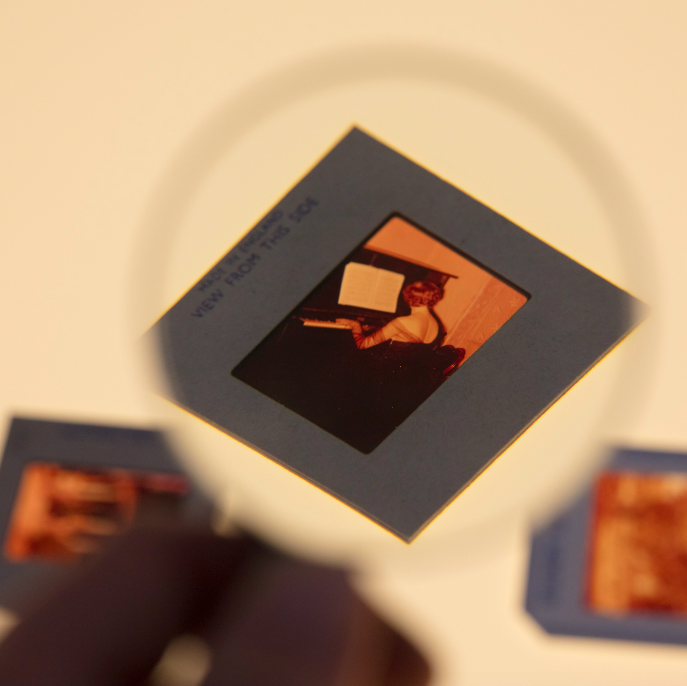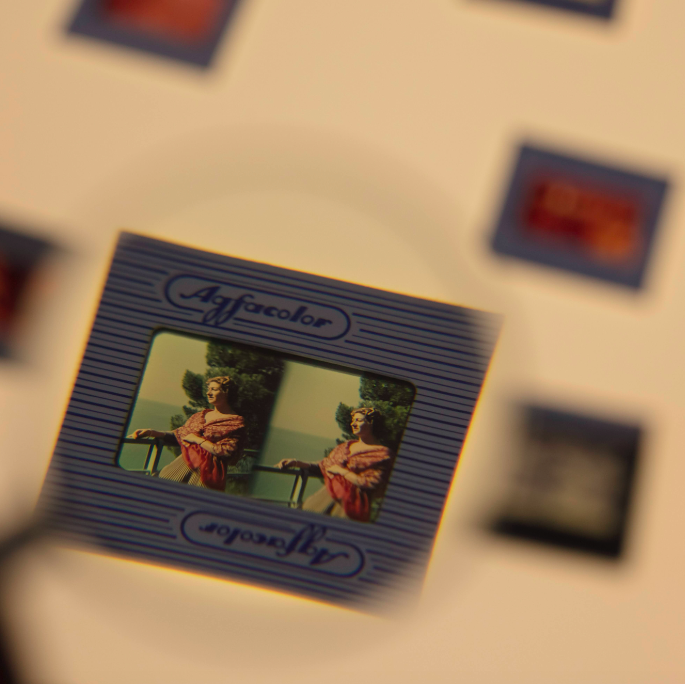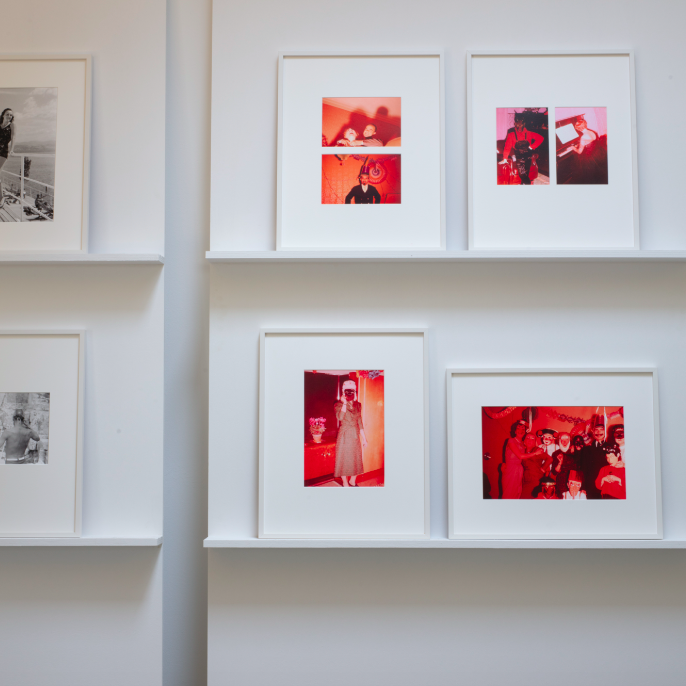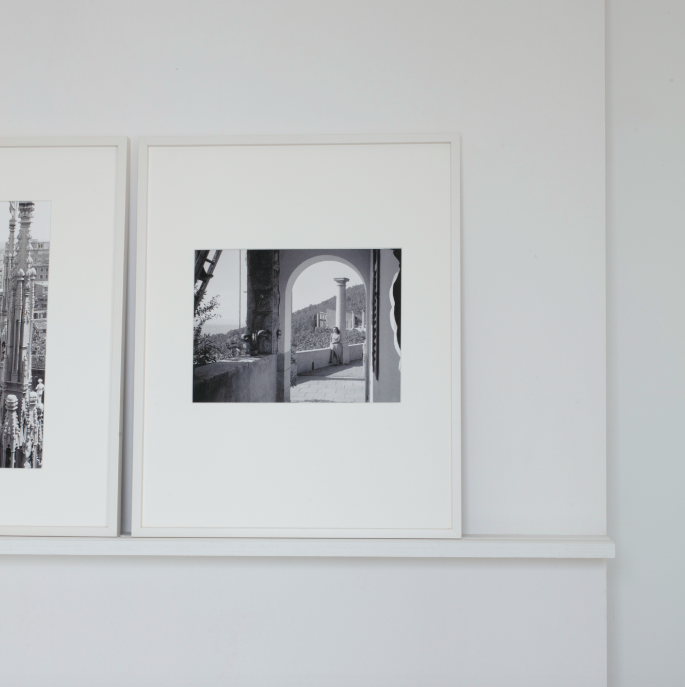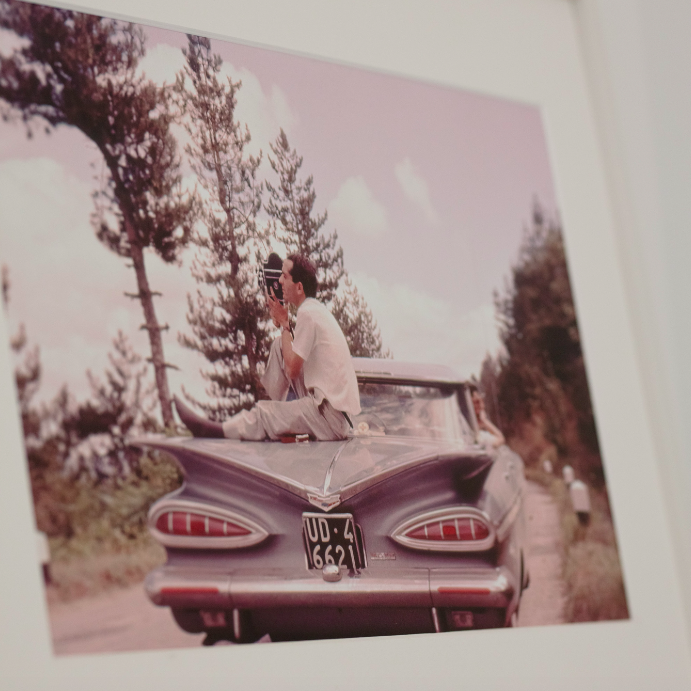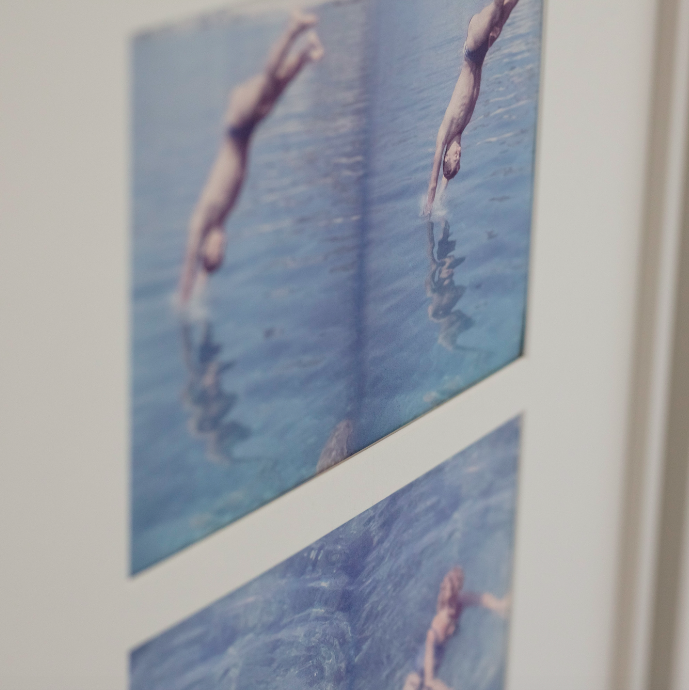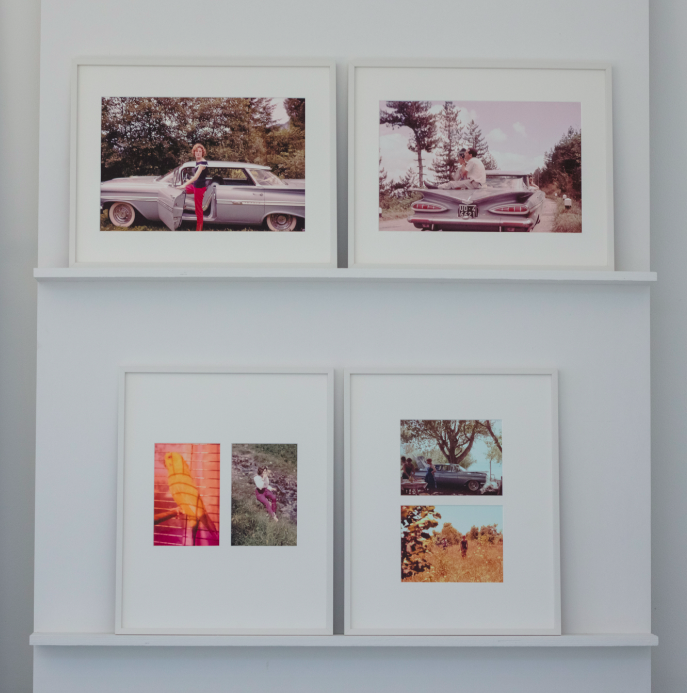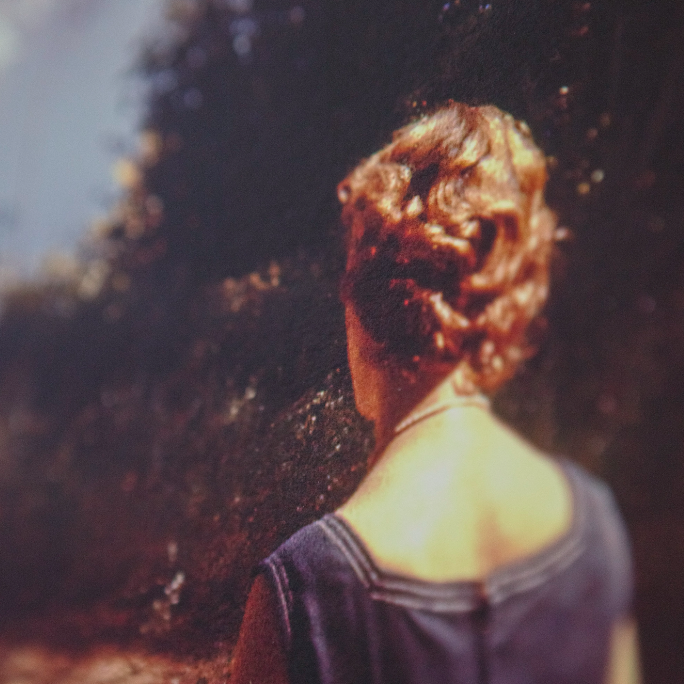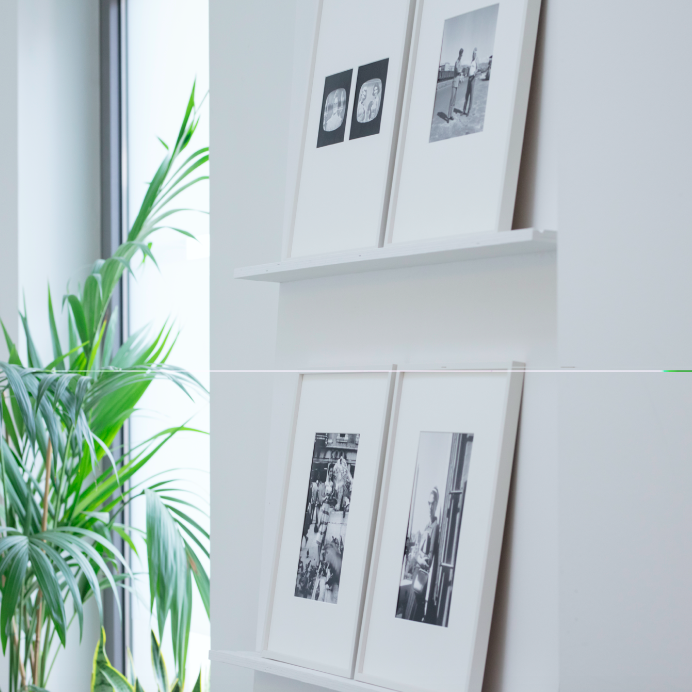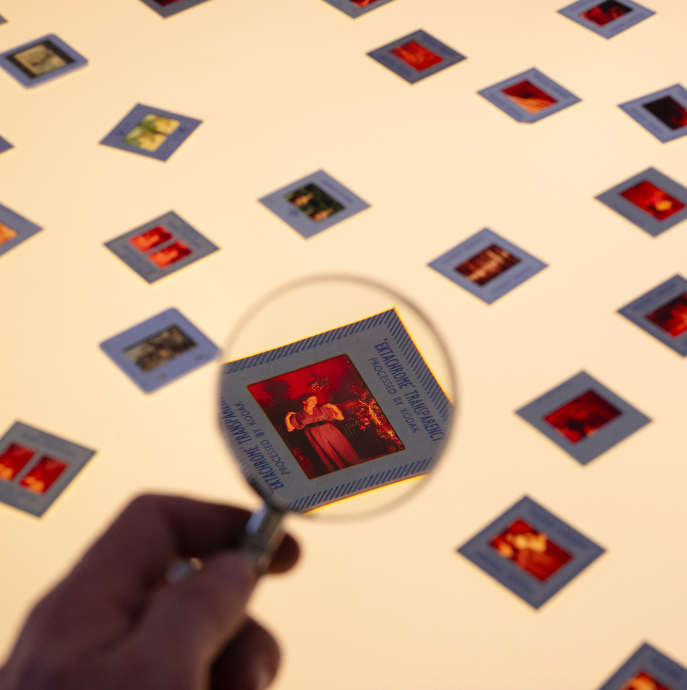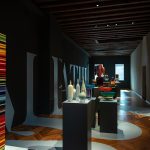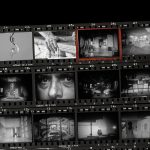english below
In mostra da Arcipèlago una cinquantina di fotografie, ma quanto è ampia la tua collezione?
Cristian Malisan – Ne ho molte…non chiedetemi quante perchè non le ho mai contate. Sono un monomaniaco disordinato; un accumulatore seriale.
- Lost&Found, ph. Matteo Lavazza Seranto
Quando è iniziata questa passione / missione di collezionare fotografie anonime?
CM – A memoria una decina di anni fa trovando un rullo 120 all’interno di una vecchia fotocamera a soffietto. Ero ad un mercatino dell’usato, già collezionavo fotocamere analogiche, e trovo questa Folding intatta, perfetta, senza fori nel soffietto, ancora nella sua custodia; al suo interno perfettamente riavvolto il rullino. Credo sia cominciato lì, dallo sviluppo di quel rullino; tre foto buone ma che aprivano un mondo che nessuno aveva visto da almeno 50 anni.
Credo sia cominciato lì, dallo sviluppo di quel rullino;
tre foto buone ma che aprivano un mondo che nessuno aveva visto da almeno 50 anni.
- Lost&Found, ph. Matteo Lavazza Seranto
Come si svolge la ricerca delle immagini – sei tu a cercare loro o loro a trovare te?
CM – Bisogna precisare che io non colleziono fotografie stampate ma negativi e diapositive. All’inizio mi trovavano loro facendosi riconoscere dai banchetti dell’usato dove nessuno le voleva…troppo difficili da utilizzare per essere comprate da tutti. Del resto mi ricordo bene che a casa si conservavano le foto stampate e quasi mai i negativi. Ormai sono io a trovare loro…ci sono amici rigattieri che appena ne trovano conservano i negativi per me. Diverse immagini di Lost & Found le ho recuperate in un mercatino dell’usato da un sacchetto di immondizia dove un rigattiere le stava gettando; ho dovuto comprare direttamente il sacchetto.
Diverse immagini di Lost & Found le ho recuperate in un mercatino dell’usato da un sacchetto di immondizia dove un rigattiere le stava gettando; ho dovuto comprare direttamente il sacchetto.
- Lost&Found, ph. Matteo Lavazza Seranto
Hai messo a disposizione queste immagini e i negativi in mostra per la prima volta da Arcipèlago, o ti è capitato di esporle già in precedenza – magari con la scelta di decenni differenti? Il progetto avrà un proseguo?
CM – Questa è la prima volta che le espongo… soprattutto in modo organizzato. Prima erano solo ad “uso personale”…adesso anche Charlotte ed Artemio ne sono consumatori. Non saprei rispondere alla questione del “divenire”… chiederò ai soggetti fotografati cosa ne pensano e vi farò sapere.
- Lost&Found, ph. Matteo Lavazza Seranto
Perché hai scelto proprio la fascia anni 40 – 60?
CM – Perché soprattutto corrispondono alle immagini che ho trovato. Immagino sia anche una questione sociale e tecnologica; prima degli anni 40 la fotografia e le fotocamere erano troppo complesse ed elitarie per essere considerate un hobby e destinate ad un uso prettamente professionale. Dopo la tecnologia si è evoluta, le fotocamere si sono semplificate, consentendo a più persone di “fotografare”. Dopo il 60 in realtà non ne ho mai trovate. Credo siano di scarso interesse anche per i rigattieri. O magari sono tutte ancora nei cassetti.
- Lost&Found, ph. Matteo Lavazza Seranto
C’è un criterio particolare per la scelta di una determinata immagine al posto di un’altra o “tutto è concesso”?
CM – Per quanto riguarda la mostra devo dire che Charlotte ed Artemio sono bravissimi… Assieme abbiamo fatto una selezione ragionata soprattutto con il cuore…
Assieme abbiamo fatto una selezione ragionata soprattutto con il cuore…
Per quanto riguarda la mia selezione ai mercatini devo dire che compro a prescindere! I soggetti fotografati ed i fotografi hanno tutti la stessa dignità!
I soggetti fotografati ed i fotografi hanno tutti la stessa dignità!
- Lost&Found, ph. Matteo Lavazza Seranto
Quasi in veste di eroe, spieghi di voler “salvare queste famiglie dall’oblio del tempo”. Da dove nasce questa urgenza? E come mai scegliere di rendere visibili e di conseguenza pubbliche delle immagini – agli occhi dei proprietari originari sicuramente intime – che forse volevano rimanere tali, appunto intime, non svelate ad un ampio pubblico?
Mi sorge spontanea l’associazione a Vivian Maier, che rimase nell’anonimato fino al 2007, quando il suo archivio fotografico venne alla luce. Sebbene la tua mostra tocca il tema della fotografia vernacolare, hai mai accarezzato l’idea di riuscire a scovare un vero talento appartenuto ad una di quelle famiglie di cui proteggi il ricordo?
CM – Dovete immaginare una vecchia casa che deve essere svuotata perché venduta o perché i proprietari non sono più in vita. I parenti più prossimi (o chi per loro) fanno un primo sopralluogo salvano le cose a loro care e poi chiamano dei rigattieri a prendere tutto il resto. Quando anche le foto vengono scartate significa che un ramo familiare si è estinto; non ci sono parenti prossimi, amici, conoscenti a voler salvare i volti ed i ricordi di queste persone. Sul fatto della volontà o meno di mostrare le immagini è una questione che le società evolute, dopo il digitale, devono ancora risolvere.
Vivian Maier è diventato un caso; anzi “molti casi”…è una questione che riguarda la fotografia, la psicologia, il marketing. Personalmente trovo la mia ricerca più affine al lavoro di Erik Kessels o di Joseph Cornell (soprattutto i video) o del già menzionato Bohumil Hrabal che nella sua “Solitudine troppo rumorosa” salvava i libri dal macero trasformandoli in qualcos’altro…
Personalmente trovo la mia ricerca più affine al lavoro di Erik Kessels o di Joseph Cornell
(soprattutto i video) o del già menzionato Bohumil Hrabal che nella sua “Solitudine troppo rumorosa” salvava i libri dal macero trasformandoli in qualcos’altro…
- Lost&Found, ph. Matteo Lavazza Seranto
Ti è capitato che qualcuno si riconoscesse nei vostri scatti o che trovasse dei volti familiari?
CM – Ancora no. Nella realtà non so se davvero vorrei conoscere la “verità oggettiva”, mi sono affezionato alle MIE persone.
- Lost&Found, ph. Matteo Lavazza Seranto
La ricerca prosegue? Nei limiti geografici territoriali o ti è capitato di fare ritrovamenti anche in altri città, altri paesi?
CM – Se sono in giro per altre città o per altri paesi generalmente è per lavoro; non c’è mai tempo per girare da rigattieri. In vacanza mi dedico alla famiglia (che già sopporta le mie monomanie). Ma si… è successo. Quello che evito è il web, non cerco e non compro mai fotografie sul web.
- Lost&Found, ph. Matteo Lavazza Seranto
Lost & Found è un viaggio spazio temporale. È impossibile non fantasticare guardando queste immagini, immaginare storie, fatti… non ti viene spontaneo provare a cucire delle storie attorno a queste immagini? Pur nella perdita delle identità che le popolano, queste immagini si portano dietro un carico emotivo denso. Alcune trasudano leggerezza, serenità, altre melancolia. Come si pone il pubblico davanti ad un simile progetto? Guardano ma non toccano o hanno voglia di portare via con sé un pezzo di storie anonime?
CM – Ovviamente sono uno che guarda le finestre illuminate di notte e che rincorre con curiosità le vite delle persone nelle sale d’attesa degli aeroporti. La chiave di lettura di Lost & Found è proprio questa.
Ovviamente sono uno che guarda le finestre illuminate di notte e che rincorre con curiosità le vite delle persone nelle sale d’attesa degli aeroporti.
La chiave di lettura di Lost & Found è proprio questa.
Anche se molte delle immagini potrebbero essere state scattate da fotografi famosi e realizzate con molta condizione di causa vorrei che gli spettatori si interessassero alle persone prima che alla qualità fotografica. La questione è che nessuno di noi può guardare la realtà oggettiva delle immagini esposte; non c’è mai la verità assoluta e rimane solo la fantasia dello spettatore.
La questione è che nessuno di noi può guardare la realtà oggettiva delle immagini esposte;
non c’è mai la verità assoluta e rimane solo la fantasia dello spettatore.
Di Vivian Maier conosciamo il volto ed il suo lavoro di reportage (street photo si dice oggi), delle sue foto “familiari” sappiamo molto. A differenza sua (o per meglio dire del curatore) gli artisti che ho citato un paio di risposte fa restituiscono in modo “soggettivo” le immagini ritrovate; tutti e tre in qualche modo colmano la perdita di identità dei soggetti rappresentati (e del fotografo) trascendendola. Le fotografie non corrispondono alle vite delle persone rappresentate ma piuttosto alla loro visione da parte del fotografo, successivamente anche all’interpretazione dello spettatore, ma il fotografo è l’unico a conoscere la realtà “vera”.
Le fotografie non corrispondono alle vite delle persone rappresentate ma piuttosto alla loro visione da parte del fotografo, successivamente anche all’interpretazione dello spettatore, ma il fotografo è l’unico a conoscere la realtà “vera”.
Tutti gli altri sguardi interpretano, offrono strade e visioni diverse, fanno in modo che le queste storie continuino in altre forme ed in altri modi.
- Lost&Found, ph. Matteo Lavazza Seranto
La nascita di Arcipèlago ha letteralmente dato una piccola scossa al tessuto creativo in cui si muove. Già dal primo progetto si è percepito questo fremito di curiosità. Di chi è quel lavoro, cosa va, dove espone, con chi lavora. Un motore acceso verso nuove connessioni e nuovi progetti. L’Ospite Sospeso di Matteo Lavazza Seranto — che ha realizzato le immagini di allestimento anche di Lost & Found — ne è un esempio. Percepite quanto sta accadendo?
Charlotte & Artemio – Abbiamo fondato Arcipèlago con il forte desiderio di creare nuovi legami, esplorare diversi mezzi e discipline e mostrare ciò che amiamo in un’atmosfera allegra.
Abbiamo fondato Arcipèlago con il forte desiderio di creare nuovi legami, esplorare diversi mezzi e discipline e mostrare ciò che amiamo in un’atmosfera allegra.
Il primo scopo è stato innanzitutto di costruire una rete attiva, amichevole e versatile. Nel corso delle nostre attività professionali, collaboriamo ogni giorno con fotografi, grafici, illustratori, autori. Cerchiamo di estendere queste collaborazioni a progetti artistici, che sfuggono alla routine del lavoro per scoprire altri aspetti di ciascuno. Molte delle persone con cui lavoriamo quotidianamente hanno anche un’attività artistica, fanno delle ricerche su vari campi della creatività, ma spesso non hanno il tempo di dedicarsene completamente. Con Arcipèlago, abbiamo voluto offrire una finestra di libertà per loro, per noi, per concederci il tempo di tuffarci nelle nostre passioni.
Con Arcipèlago, abbiamo voluto offrire una finestra di libertà per loro, per noi, per concederci il tempo di tuffarci nelle nostre passioni.
Si chiama galleria, ma si potrebbe dire un luogo dove condividere idee, curiosità e connessioni.
- Lost&Found, ph. Matteo Lavazza Seranto
Fotografia e scultura e poi grafica e poi di nuovo fotografia. Cosa riserva Arcipèlago per il futuro?
C & A – Dopo la mostra Lost and Found ci concediamo un piccolo intervallo per concentrarci su altri progetti che abbiamo a cuore da portare avanti. Abbiamo ideato Arcipèlago come una galleria effimera, per non sentirci obbligati di seguire una programmazione fissa. Ci piace molto l’idea di esplorare le diverse opportunità, di sfruttare le sorprese che accadono per caso e di permetterci uno spazio di libertà totale senza tempistiche strette.
Abbiamo ideato Arcipèlago come una galleria effimera, per non sentirci obbligati di seguire una programmazione fissa.
Ci piace molto l’idea di esplorare le diverse opportunità, di sfruttare le sorprese che accadono per caso e di permetterci uno spazio di libertà totale…
Nel 2022 festeggeremo i vent’anni dello studio Designwork, che ci ospita, e sarà una bellissima occasione per costruire con loro una mostra retrospettiva.
A settembre abbiamo un progetto collettivo sulla materia, con opere in tessuto, in legno, in ceramica, in sabbia, dalle tonalità molto naturali. Infine nei nostri programmi c’è anche una mostra sulla tecnica del collage, un’altra di fotografia su New York e Los Angeles, e un grande progetto collettivo sul tema del mare.
- Lost&Found, ph. Matteo Lavazza Seranto
A proposito de L’Ospite Sospeso si è trattato di un’installazione che ha messo in luce il MLS più intimo, più sperimentale, il lato più artistico della tua pratica. Nel caso di Lost & Found invece hai documentato un progetto fotografico altrui. Sei entrato nelle vite e nei ricordi di figure sbiadite fissandole nuovamente su pellicola. Da un lato la documentazione, dall’altro la partecipazione. Quanto l’una influisce sull’altra?
Matteo Lavazza Seranto – Coltivo un approccio voyeuristico alla realtà che mi circonda. Sia nel momento di creare le “mie realtà” de L’Ospite Sospeso che quando vengo chiamato a testimoniare le visioni altrui.
Coltivo un approccio voyeuristico alla realtà che mi circonda.
Sia nel momento di creare le “mie realtà” de L’Ospite Sospeso che quando vengo chiamato a testimoniare le visioni altrui.
Questa stupefacente collezione di immagini apre porte su percorsi narrativi inaspettati ed è per questo che, al momento di posizionare la mia camera per le riprese dell’allestimento, mi sono lasciato attrarre dalle eco che mi suggerivano questi reperti fino a costruire nuove storie intorno alle storie già presenti. Andando a spiare i dettagli, mi sono avvicinato sempre più. Mi sono perso e ritrovato.
Andando a spiare i dettagli, mi sono avvicinato sempre più. Mi sono perso e ritrovato.
- Lost&Found, ph. Matteo Lavazza Seranto
Viene spontaneo chiedersi cosa L’Ospite Sospeso si porta dietro. Ma questa è un’altra storia….
MLS – Tu hai parlato di un fremito che Arcipelago ha generato. Io sono figlio di questa energia a lungo sopita.
Tu hai parlato di un fremito che Arcipelago ha generato.
Io sono figlio di questa energia a lungo sopita.
A maggio 2021 la prima edizione di Arcipelago poi a novembre una personale nel mio atelier. Lost and Found è per me un tributo all’energia creativa di Cristian e Charlotte e Artemio. L’Ospite Sospeso si alimenta di tutto questo. Respinge l’idea di fissità, un’ode alla memoria, alla luce e alla vita che scorre tra due frazioni di tempo.
Lost and Found è per me un tributo all’energia creativa di Cristian e Charlotte e Artemio.
L’Ospite Sospeso si alimenta di tutto questo.
Respinge l’idea di fissità, un’ode alla memoria, alla luce e alla vita che scorre tra due frazioni di tempo.
- Lost&Found, ph. Matteo Lavazza Seranto
About fifty photographs are on display at Arcipèlago, but how large is your collection?
Cristian Malisan – I have lots … don’t ask me how many because I’ve never counted them. I’m a messy monomaniac; a serial accumulator.
- Lost&Found, ph. Matteo Lavazza Seranto
When did this passion / mission of collecting anonymous photographs begin?
CM – From memory, about ten years ago, finding a 120 roll inside an old bellows camera. I was at a flea market, I was already collecting analogue cameras, and I found this folding camera intact, perfect, without holes in the bellows, still in its case; the roll still perfectly rewound inside. I think it started there, from developing that roll; only three good photos but that opened up a world that no one had seen for at least 50 years.
I think it started there, from developing that roll;
only three good photos but that opened up a world that no one had seen for at least 50 years.
- Lost&Found, ph. Matteo Lavazza Seranto
How does the image search work – do you look for them or do they find you?
CM – It must be pointed out that I do not collect printed photographs but negatives and slides. At the beginning they found me by making themselves known from second-hand stalls where no one wanted them … too difficult to use for just anyone to buy. After all, I remember well that at home the printed photos were kept, the negatives: almost never. Now I’m the one to find them … there are junk dealer friends who, as soon as they find negatives, keep them for me. I recovered several images in Lost & Found in a flea market from a garbage bag where a second-hand dealer was throwing them; I had to buy the entire bag.
I recovered several images in Lost & Found in a flea market from a garbage bag where a second-hand dealer was throwing them; I had to buy the entire bag.
- Lost&Found, ph. Matteo Lavazza Seranto
Did you make these images and the negatives on display at Arcipèlago available for the first time, or or have you exhibited them previously – perhaps by choosing different decades? Will the project be continued?
CM – This is the first time I’ve exhibited them … certainly in an organized way. Before they were only for “personal use” … now even Charlotte and Artemio are consumers. I can’t answer the question of “continuing” … I’ll ask the photographed subjects what they think and I’ll let you know.
- Lost&Found, ph. Matteo Lavazza Seranto
Why did you choose the decades from the 40s to the 60s?
CM – Most of all because they correspond to the images I’ve found. I guess it is also a social and technological issue; before the 40s, photography and cameras were too complex and elitist to be considered a hobby and intended for purely professional use. As technology has evolved, cameras have become simplified, allowing more people to “photograph.” After the 60s, I have never actually found any. I think they are of little interest even for junk dealers. Or maybe they’re all still hidden in drawers.
- Lost&Found, ph. Matteo Lavazza Seranto
Is there a particular criterion for choosing a certain image instead of another or is “everything allowed”?
CM – As far as the exhibition is concerned, I must say that Charlotte and Artemio are very good … Together we made a reasoned selection truly from the heart…
Together we made a reasoned selection truly from the heart…
As for my selection at the flea markets I must say that I buy regardless! The photographed subjects and photographers all have the same dignity!
The photographed subjects and photographers all have the same dignity!
- Lost&Found, ph. Matteo Lavazza Seranto
Almost in the guise of a hero, you explain that you want to “save these families from the oblivion of time.” Where does this urgency come from? And why choose to make images visible and consequently public – which were, in the eyes of the original owners, certainly intimate – who perhaps wanted them to remain so, solely intimate, not disclosed to a wider public? – The association with Vivian Maier arises spontaneously, and she remained anonymous until 2007, when her photographic archive came to light. Although your exhibition touches on the theme of vernacular photography, have you ever cherished the idea of being able to find a genuine talent belonging to one of those families whose memory you protect?
CM – You have to imagine an old house that has to be emptied because it was sold or because the owners are no longer alive. The closest relatives (or whoever they are) make an initial inspection, save the things they love and then call junk dealers to take everything else. When the photos are also discarded it means that a family branch has become extinct; there are no close relatives, friends, acquaintances who want to save the faces and the memories of these people. Whether to exhibit images or not is a question that evolved societies, in the post-digital age, have yet to resolve.
Vivian Maier became an event; indeed “many events” … it is a matter that concerns photography, psychology, marketing. Personally, I find my research more akin to the work of Erik Kessels or Joseph Cornell (especially the videos) or the aforementioned Bohumil Hrabal who in his “Too noisy Solitude” saved books from being thrown away by transforming them into something else….
Personally, I find my research more akin to the work of Erik Kessels or Joseph Cornell (especially the videos) or the aforementioned Bohumil Hrabal who in his “Too noisy Solitude” saved books from being thrown away by transforming them into something else….
- Lost&Found, ph. Matteo Lavazza Seranto
Has it ever happened that someone recognized themselves in your shots or that found familiar faces?
CM – Not yet. To be honest I don’t know if I really would like to know the “objective truth”, I have grown fond of MY people.
- Lost&Found, ph. Matteo Lavazza Seranto
Is the search continuing? Within the territorial limits of Italy, or have you also made discoveries in other cities, other countries?
CM – If I am travelling to other cities or other countries it is usually for work; there is never time to go to second-hand dealers. On vacation, I dedicate myself to my family (who already endure my monomanias). But yes… it happened. What I avoid is the web; I never search and never buy photographs on the web.
- Lost&Found, ph. Matteo Lavazza Seranto
Lost & Found is a space-time journey. It is impossible not to fantasize looking at these images, to imagine stories, facts … doesn’t it come naturally to you to try to stitch stories around these images? Despite the loss of the identities that populate them, these images carry with them a dense emotional load. Some exude lightness, serenity, others melancholy. How does the public confront a project like this? Do they look but not touch, or do they feel like taking a piece of one of these anonymous stories away with them?
CM – Obviously I am someone who looks at lighted windows at night and who curiously chases the lives of people in airport departure lounges. The key to reading Lost & Found is exactly this.
Obviously I am someone who looks at lighted windows at night and who curiously chases the lives of people in airport departure lounges.
The key to reading Lost & Found is exactly this.
While many of the images may have been taken by famous photographers and taken with a lot of background knowledge, I would like viewers to be interested in people rather than photographic quality. The point is that none of us can look at the objective reality of the images on display; there is never the absolute truth and all that remains is the viewer’s imagination.
The point is that none of us can look at the objective reality of the images on display;
there is never the absolute truth and all that remains is the viewer’s imagination.
We know the face and the reportage work of Vivian Maier (street photo, as it’s called today), we know a lot about her “family” photos. Unlike her (or rather the curator), the artists I cited a couple of replies ago return the found images in a “subjective” way; all three in some way fill the loss of identity of the subjects represented (and of the photographer) by transcending it. The photographs do not correspond to the lives of the people represented but rather to the photographer’s vision of them, subsequently also to the spectator’s interpretation, but the photographer is the only one who knows the “true” reality. All the other gazes interpret, offer different paths and visions, make these stories continue in other forms and in other ways.
The photographs do not correspond to the lives of the people represented but rather to the photographer’s vision of them, subsequently also to the spectator’s interpretation, but the photographer is the only one who knows the “true” reality.
- Lost&Found, ph. Matteo Lavazza Seranto
The birth of Arcipèlago has literally given a little shake to the creative fabric in which it moves. This thrill of curiosity was felt right from the first project. Whose work is it, where is it going, where does it exhibit, who does it work with? An engine running towards new connections and new projects. L’Ospite Sospeso (The Suspended Guest) by Matteo Lavazza Seranto – who also created the installation images for Lost & Found – is an example. Can you perceive what is happening?
Charlotte & Artemio – We founded Arcipèlago with the strong desire to create new bonds, explore different mediums and disciplines and show what we love in a cheerful atmosphere.
We founded Arcipèlago with the strong desire to create new bonds, explore different mediums and disciplines and show what we love in a cheerful atmosphere.
The primary aim was to build an active, friendly and versatile network first and foremost. In the course of our professional activities, we collaborate every day with photographers, graphic designers, illustrators, authors. We try to extend these collaborations to artistic projects, which escape the routine of work to discover other aspects of each one. Many of the people we work with on a daily basis also have an artistic activity; they research in various fields of creativity, but often do not have the time to devote themselves to it completely. With Arcipèlago, we wanted to offer a window of freedom for them, for us, to allow ourselves the time to dive into our passions.
It’s called a gallery, but it could also be called a place to share ideas, curiosities and connections.
With Arcipèlago, we wanted to offer a window of freedom for them, for us, to allow ourselves the time to dive into our passions.
- Lost&Found, ph. Matteo Lavazza Seranto
Photography and sculpture, then graphics and then photography once more. What does Arcipèlago have in store for the future?
C & A – After the Lost and Found exhibition we’re allowing ourselves a small break to focus on moving forward with other projects that we care about. We have conceived Arcipèlago as an ephemeral gallery, so as not to feel obliged to follow a fixed schedule. We really like the idea of exploring different opportunities, taking advantage of surprises that happen by chance and allowing ourselves a space of total freedom without tight deadlines.
We have conceived Arcipèlago as an ephemeral gallery, so as not to feel obliged to follow a fixed schedule. We really like the idea of exploring different opportunities, taking advantage of surprises that happen by chance and allowing ourselves a space of total freedom without tight deadlines.
In 2022 we will celebrate the twentieth anniversary of the Designwork studio, which hosts us, and it will be a wonderful opportunity to build a retrospective exhibition with them.
In September we have a collective project on material, with works in fabric, wood, ceramic, sand, with very natural shades. Finally, in our programme there is also an exhibition on the technique of collage, another on photography of New York and Los Angeles, and a large collective project on the theme of the sea.
- Lost&Found, ph. Matteo Lavazza Seranto
Speaking of L’Ospite Sospeso (The Suspended Guest), it was an installation that highlighted the most intimate, more experimental MLS, the most artistic side of your practice. In the case of Lost & Found, on the other hand, you have documented someone else’s photographic project. You have entered the lives and memories of faded figures by fixing them once again on film. Documentation on the one hand, participation on the other. To what extent does one affect the other?
Matteo Lavazza Seranto – I cultivate a voyeuristic approach to the reality that surrounds me. Both when creating “my realities” of L’Ospite Sospeso and when I am called to bear witness to the visions of others.
I cultivate a voyeuristic approach to the reality that surrounds me.
Both when creating “my realities” of L’Ospite Sospeso and when I am called to bear witness to the visions of others.
This amazing collection of images opens doors on unexpected narrative paths and that is why, when positioning my camera for the shooting of the installation, I let myself be attracted by the echoes that these finds suggested to me to build new stories around the stories that were already present. Going to spy on the details, I got closer and closer. I lost and found myself.
Going to spy on the details, I got closer and closer. I lost and found myself.
- Lost&Found, ph. Matteo Lavazza Seranto
It comes naturally to wonder what the Suspended Guest brings with him. But that is another story ….
MLS – You spoke of Archipelago generating a thrill. I am the child of this long dormant energy.
You spoke of Archipelago generating a thrill.
I am the child of this long dormant energy.
In May 2021 there was the first edition of Arcipelago then in November a solo exhibition in my studio. For me, Lost and Found is a tribute to the creative energy of Cristian and of Charlotte and Artemio. The Suspended Guest is fed by all of this. It spurns the notion of fixity, an ode to memory, light and life that flows between two fractions of time.
For me, Lost and Found is a tribute to the creative energy of Cristian and of Charlotte and Artemio. The Suspended Guest is fed by all of this. It spurns the notion of fixity, an ode to memory, light and life that flows between two fractions of time.
- Lost&Found, ph. Matteo Lavazza Seranto

